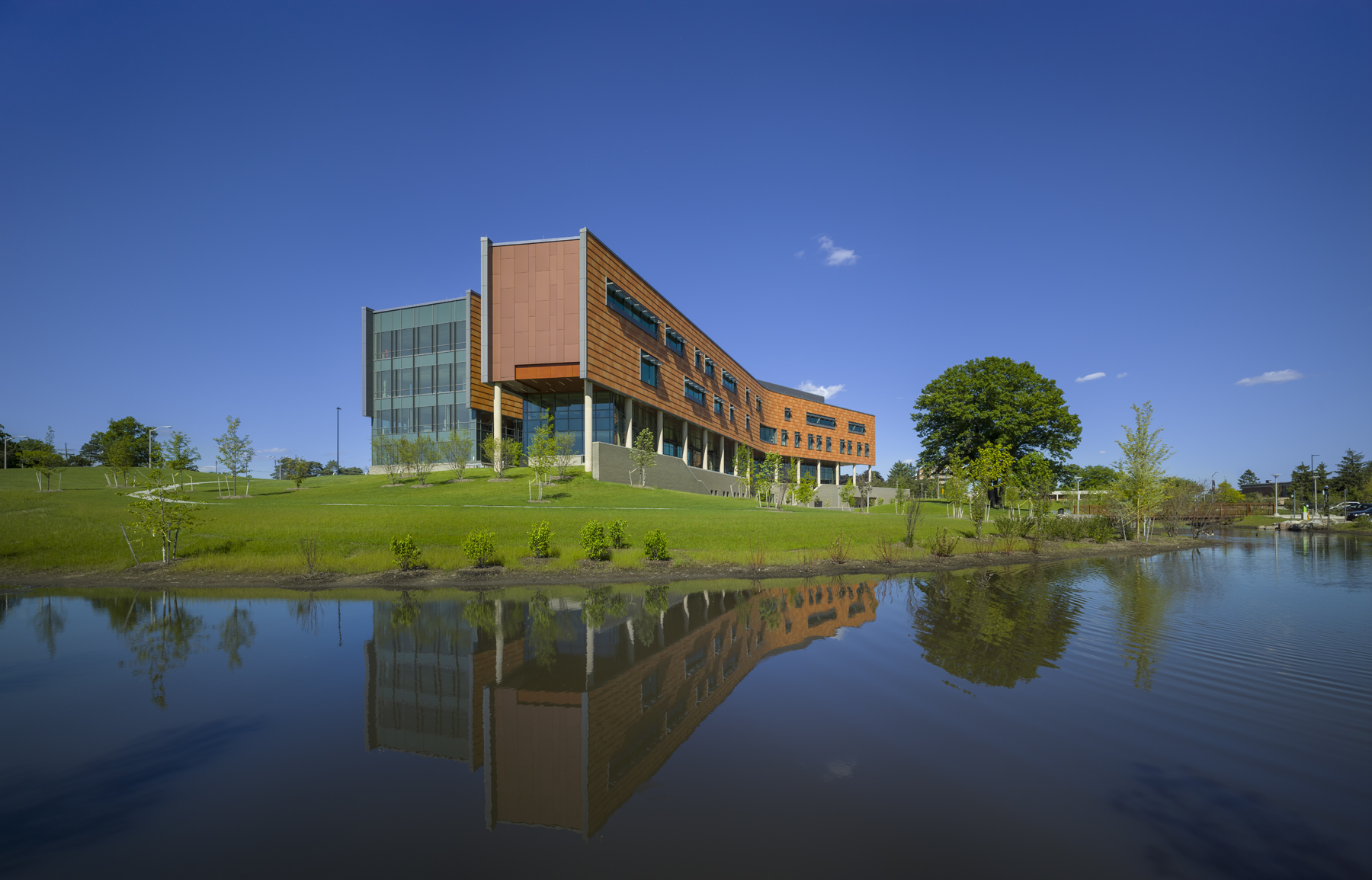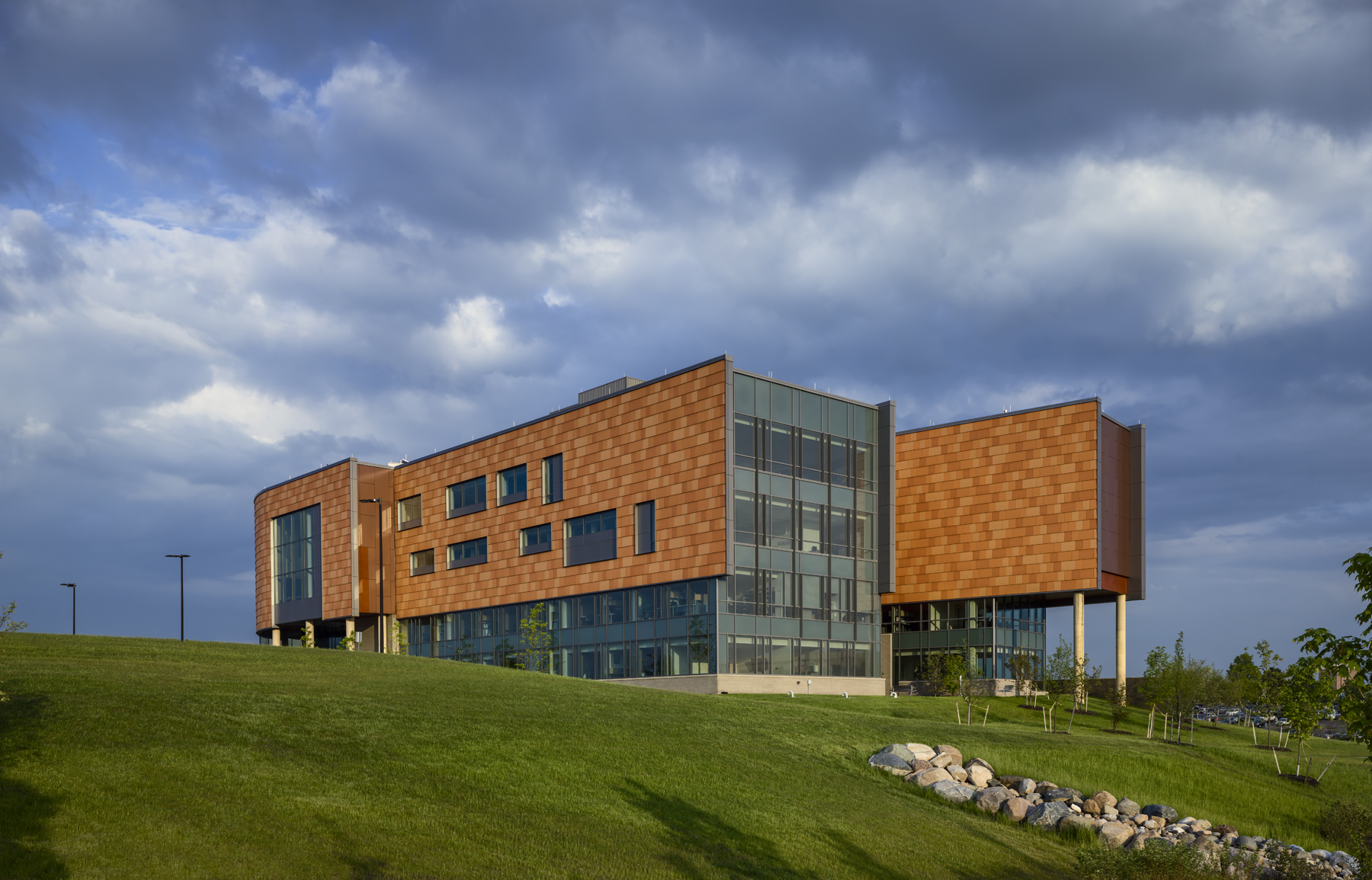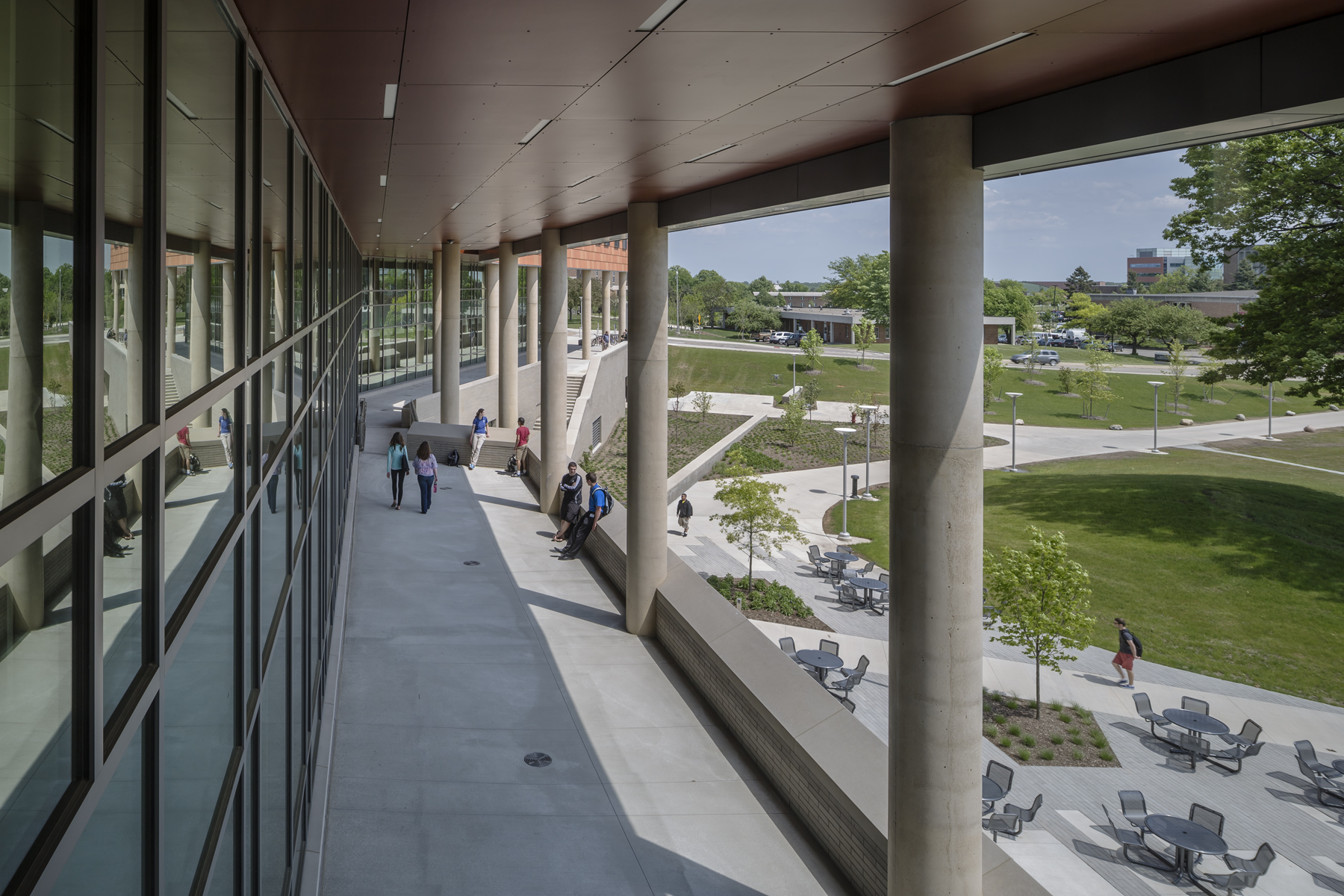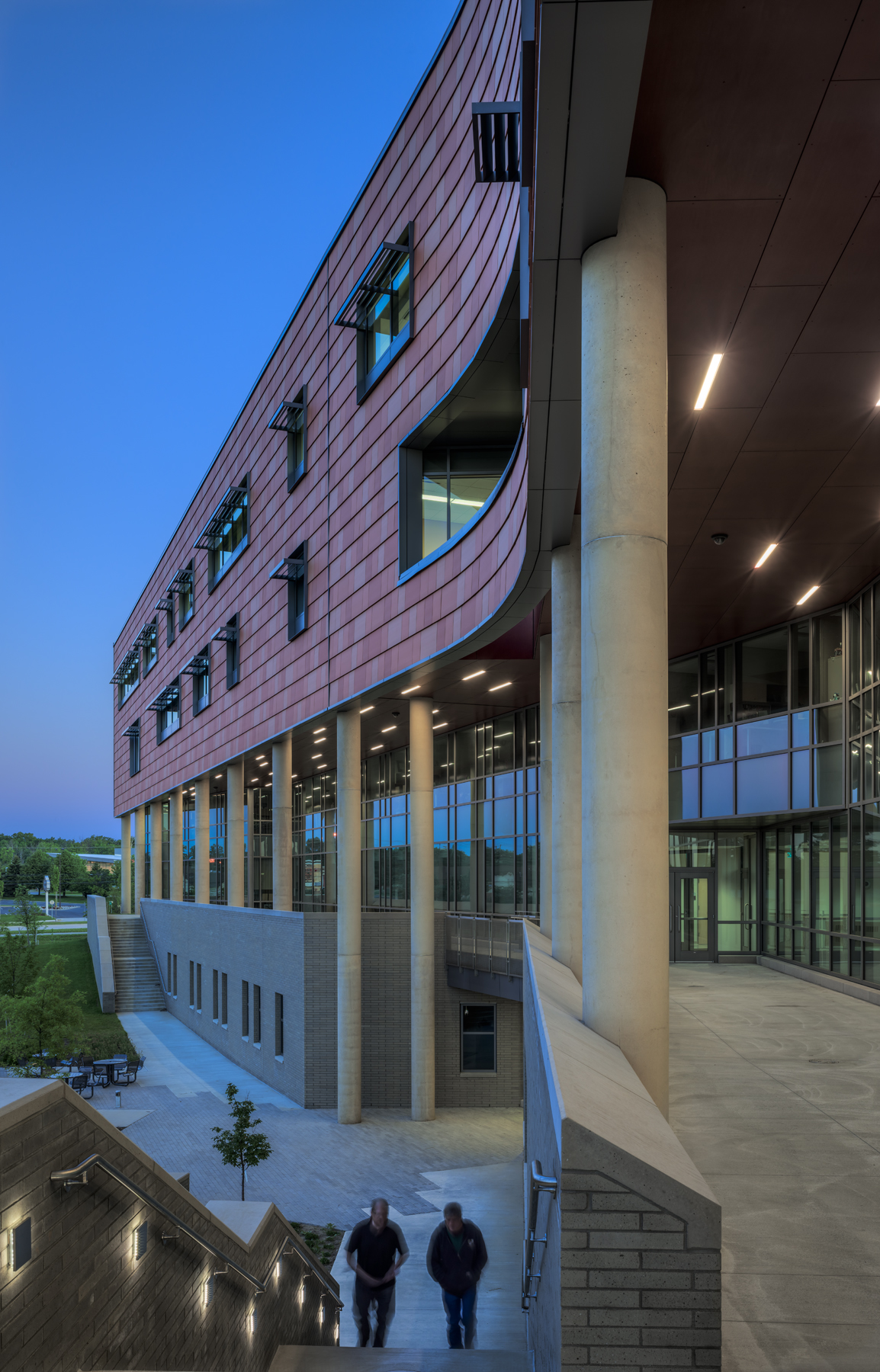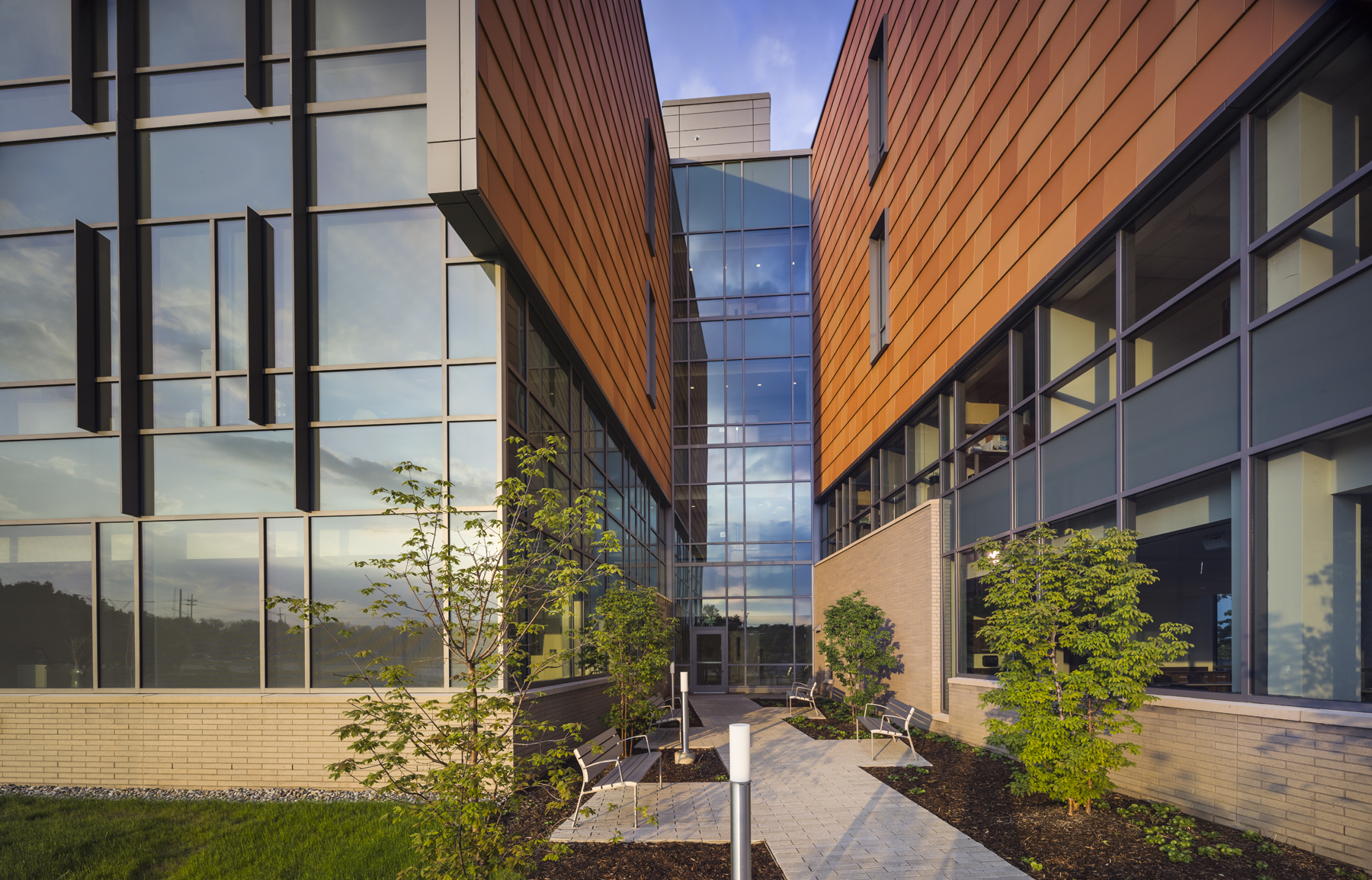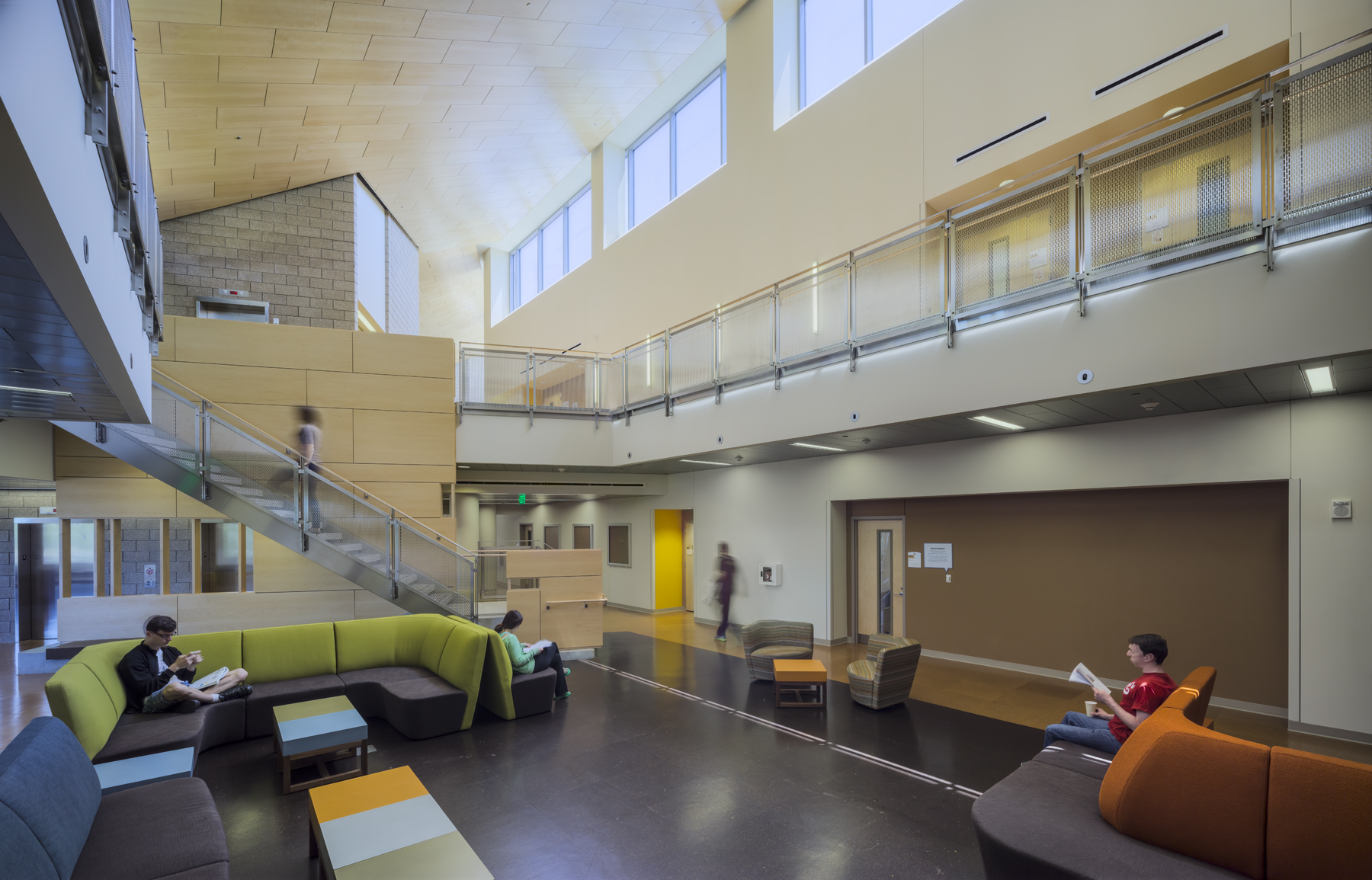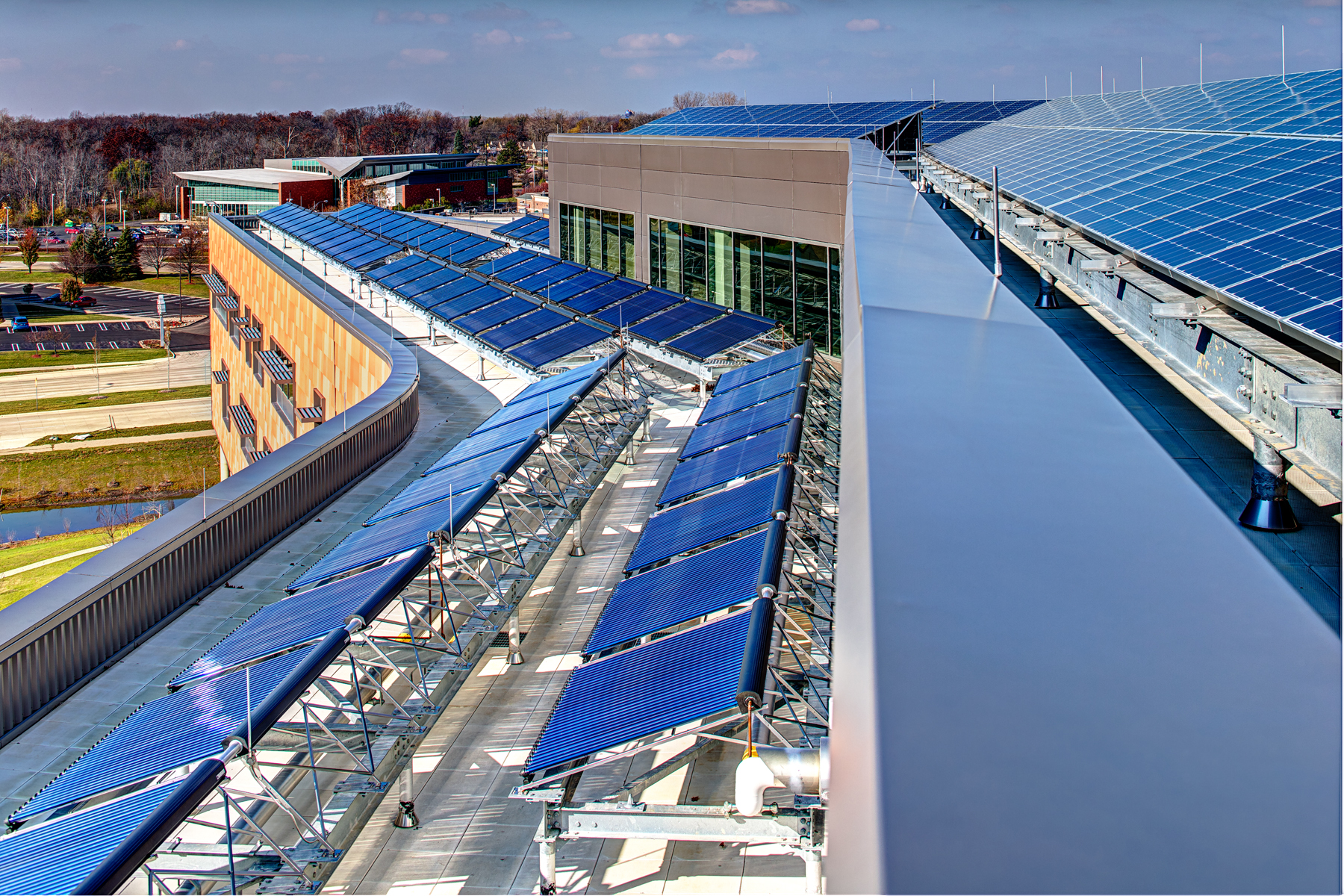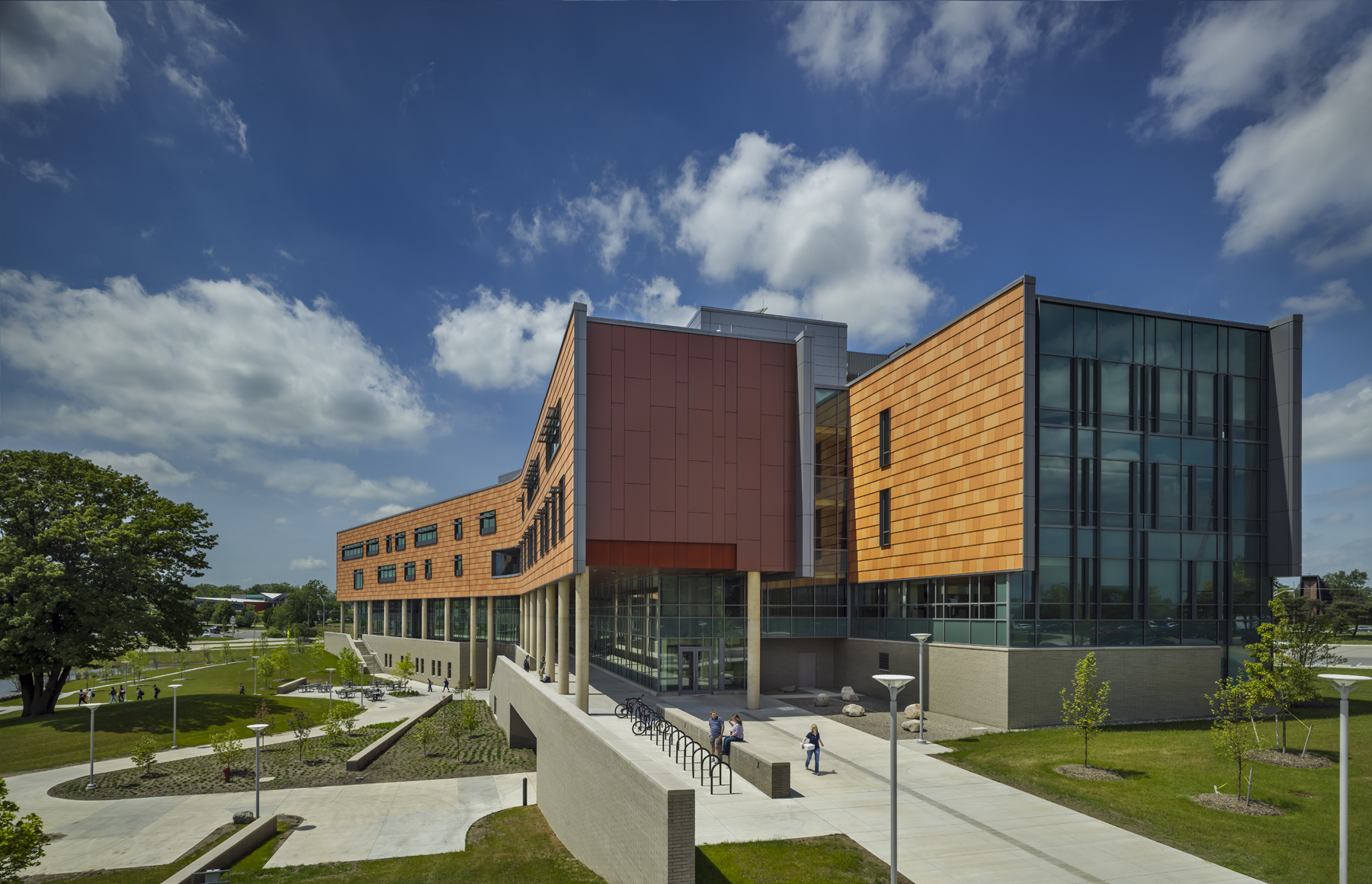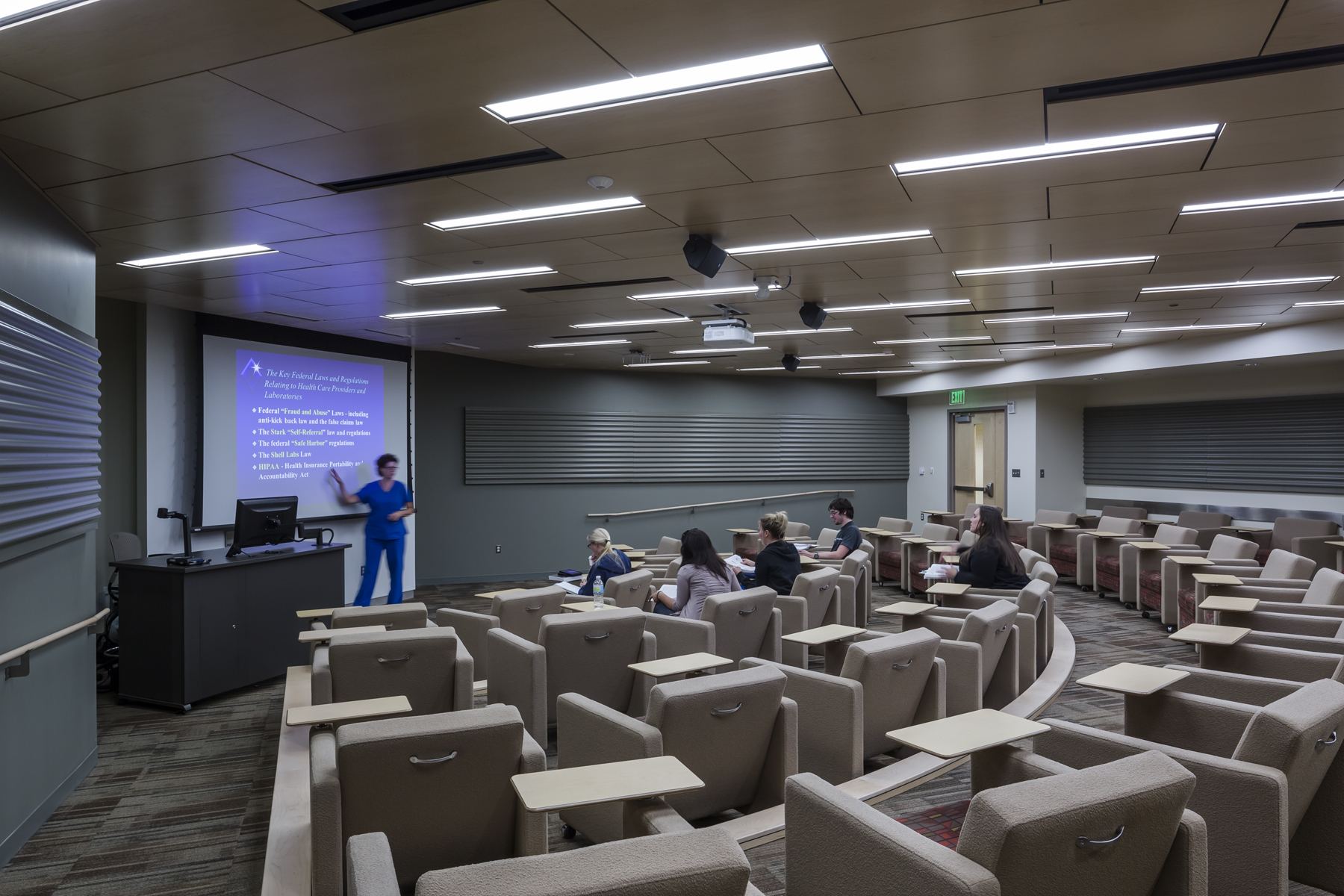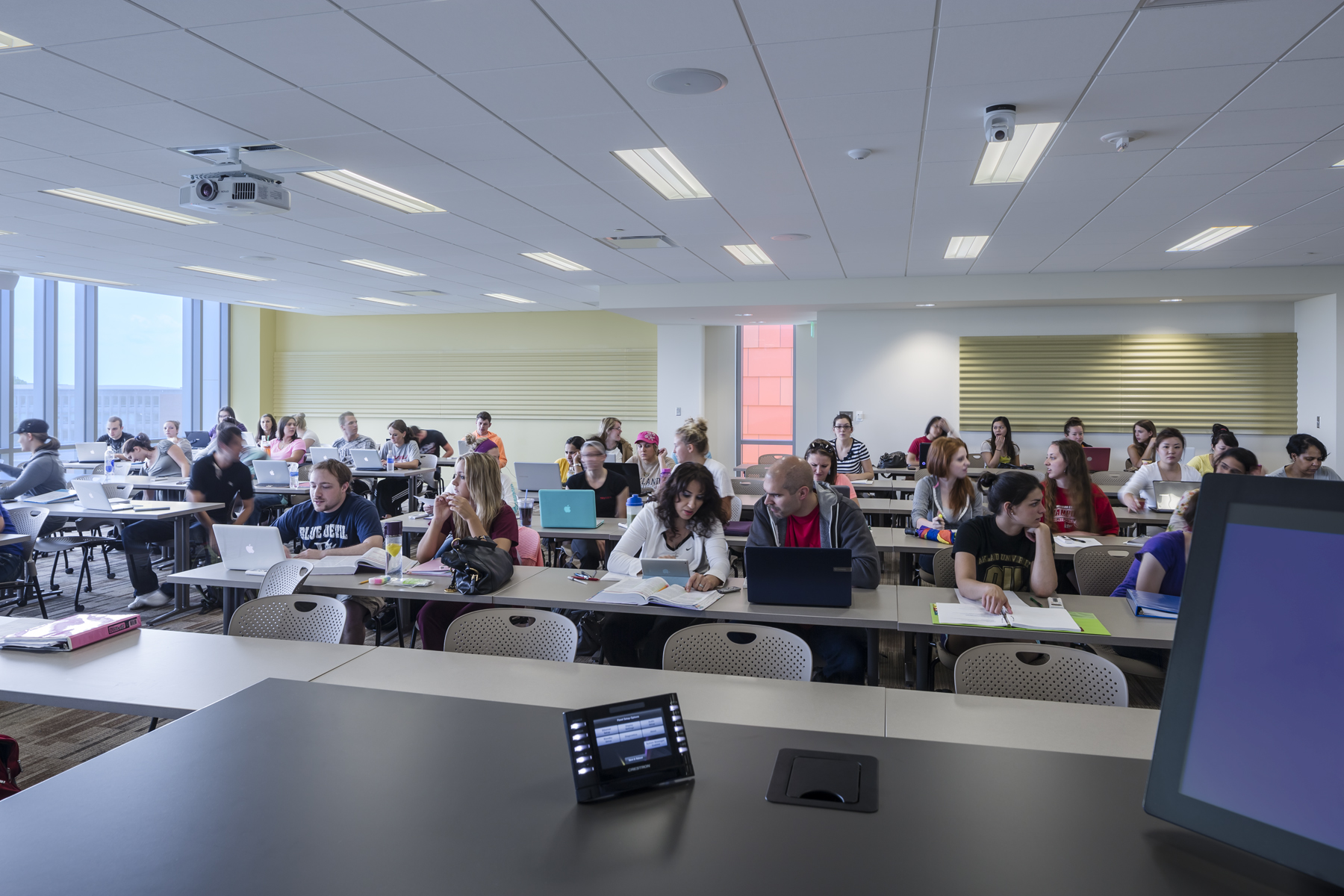The new $64 million Oakland University Human Health Building has become the first LEED Platinum certified building on a university campus in Michigan.
Designed by SmithGroupJJR, the 160,260-square-foot, five-story, terra cotta-clad building, built on the former site of a parking lot and an untended natural wetland, today features some of the industry’s most innovative, energy-efficient building systems and advanced sustainable design features.
The project’s primary funding of $40 million came from the State of Michigan legislature’s Capital Outlay Program. Then, to achieve the highest LEED rating – Platinum -- while staying on budget, Oakland University, assisted by SmithGroupJJR, successfully pursued a $2.7 million grant from the U.S. Department of Energy, allowing the project to proceed with a full geothermal and renewable energy system.
“The collaboration between Oakland University, SmithGroupJJR and The Christman Company truly benefitted our ability to design and build the most energy-efficient and sustainable building on any college campus in Michigan,” said Terry Stollsteimer, associate vice president, facilities management, Oakland University.
The facility’s energy systems are designed to save an estimated 35% in energy costs annually compared to the LEED prescribed “baseline” building.
A geothermal field, consisting of 340 wells built 320 feet underneath the university’s main parking lot, uses the earth as an energy source for heat pumps that efficiently provide heating and cooling for the building.
A total of 117 vacuum tube solar thermal panels provide “free” heat for the building in the wintertime, the desiccant dehumidification system in the summertime, and domestic water heating all year round. Four, 25,000-gallon underground tanks store any excess solar generated hot water until it’s needed.
A rooftop photovoltaic system, comprised of more than 200 solar panels covering 3,600 square feet, provides 45 kilowatts or 3% of the building’s power.
“Environmentally friendly buildings have shown to have positive effects on the quality of their occupants’ health, so it was easy for the university to decide that the new Human Health Building should be highly sustainable,” said Chris Purdy, AIA, LEED AP, SmithGroupJJR principal-in-charge for the project. SmithGroupJJR provided architectural design and development; mechanical, electrical, plumbing, structural and civil engineering; lab planning; interior design; landscape design and LEED certification and documentation.
The building’s environmental friendliness doesn’t end with the innovative, energy-efficient building systems. Outside, a grand porch created by the overhang of the upper floors protects faculty offices from the solar heat gain of a southern exposure. Exterior offices are outfitted with vertical sunshades and fritted glass to reduce glare and cut down on outside heat. Rainwater from the roof is collected and stored in a below-grade cistern, and used for site irrigation.
Inside the building, an elongated floor plan with floor-to-ceiling windows allows for abundant access to natural light and views of outdoor spaces. The interior’s use of recycled, regional and low-VOC materials includes sealed cork floors and bamboo cabinets, and walls are made with insulated cinderblock to reduce energy costs. Daylight and occupant sensors are used throughout the building to reduce energy use by occupants.
Directly south of the building is a towering, 100-year-old Oak tree that was integrated into the site design, rather than cleared. The site’s natural wetland was rehabilitated with native vegetation and invasive species were removed, thereby creating an outdoor lounge and gathering place for students.
About the Human Health Building, Oakland University
The Human Health Building (HHB) was conceived after increased student enrollment caused the university’s School of Nursing and School of Health Sciences to outgrow their separate facilities. The university envisioned a new building on the northwest corner of its 1,441-acre campus to allow the two schools a collaborative setting and an unprecedented opportunity for interaction among students, facility and community partners. Completed in August 2012, the HHB is the first structure constructed as part of the university’s proposed Health Quadrant Campus Master Plan, developed by SmithGroupJJR.
The HHB pairs advanced classrooms and hands-on instructional spaces with amenities that replicate those found in hospitals and community health centers – including a public clinic, simulation labs, and clinical and physical therapy labs. An emphasis was placed on student spaces; two-story, natural light-filled, “living room” areas on the fourth floor give students a place to gather before or after class. To learn more about the HHB from the design and construction team, go to: http://www.oakland.edu/?id=26078&sid=228
About SmithGroupJJR
SmithGroupJJR (www.smithgroupjjr.com) is a national leader in sustainable design, with 361 LEED Accredited Professionals on staff. The Oakland University HHB marks SmithGroupJJR’s 90th LEED certified project and its 11th LEED Platinum certification. The firm’s nationally recognized Learning Practice has completed the planning and design of educational facilities on over 350 campuses worldwide.
About LEED
The U.S. Green Building Council's LEED green building certification system is the foremost program for the design, construction and operation of green buildings. By using less energy, LEED-certified buildings save money for families, businesses and taxpayers; reduce greenhouse gas emissions; and contribute to a healthier environment for residents, workers and the larger community. For more information, visit www.usgbc.org.
Related Stories
Market Data | Mar 6, 2024
Nonresidential construction spending slips 0.4% in January
National nonresidential construction spending decreased 0.4% in January, according to an Associated Builders and Contractors analysis of data published today by the U.S. Census Bureau. On a seasonally adjusted annualized basis, nonresidential spending totaled $1.190 trillion.
MFPRO+ Special Reports | Mar 6, 2024
Top 10 trends in senior living facilities for 2024
The 65-and-over population is growing faster than any other age group. Architects, engineers, and contractors are coming up with creative senior housing solutions to better serve this burgeoning cohort.
Architects | Mar 5, 2024
Riken Yamamoto wins 2024 Pritzker Architecture Prize
The Pritzker Architecture Prize announces Riken Yamamoto, of Yokohama, Japan, as the 2024 Laureate of the Pritzker Architecture Prize, the award that is regarded internationally as architecture’s highest honor.
Office Buildings | Mar 5, 2024
Former McDonald’s headquarters transformed into modern office building for Ace Hardware
In Oak Brook, Ill., about 15 miles west of downtown Chicago, McDonald’s former corporate headquarters has been transformed into a modern office building for its new tenant, Ace Hardware. Now for the first time, Ace Hardware can bring 1,700 employees from three facilities under one roof.
Green | Mar 5, 2024
New York City’s Green Economy Action Plan aims for building decarbonization
New York City’s recently revealed Green Economy Action Plan includes the goals of the decarbonization of buildings and developing a renewable energy system. The ambitious plan includes enabling low-carbon alternatives in the transportation sector and boosting green industries, aiming to create more than 12,000 green economy apprenticeships by 2040.
Lighting | Mar 4, 2024
Illuminating your path to energy efficiency
Design Collaborative's Kelsey Rowe, PE, CLD, shares some tools, resources, and next steps to guide you through the process of lighting design.
MFPRO+ News | Mar 1, 2024
Housing affordability, speed of construction are top of mind for multifamily architecture and construction firms
The 2023 Multifamily Giants get creative to solve the affordability crisis, while helping their developer clients build faster and more economically.
Multifamily Housing | Feb 29, 2024
Manny Gonzalez, FAIA, inducted into Best in American Living Awards Hall of Fame
Manny Gonzalez, FAIA, has been inducted into the BALA Hall of Fame.
K-12 Schools | Feb 29, 2024
Average age of U.S. school buildings is just under 50 years
The average age of a main instructional school building in the United States is 49 years, according to a survey by the National Center for Education Statistics (NCES). About 38% of schools were built before 1970. Roughly half of the schools surveyed have undergone a major building renovation or addition.
MFPRO+ Research | Feb 28, 2024
New download: BD+C's 2023 Multifamily Amenities report
New research from Building Design+Construction and Multifamily Pro+ highlights the 127 top amenities that developers, property owners, architects, contractors, and builders are providing in today’s apartment, condominium, student housing, and senior living communities.



